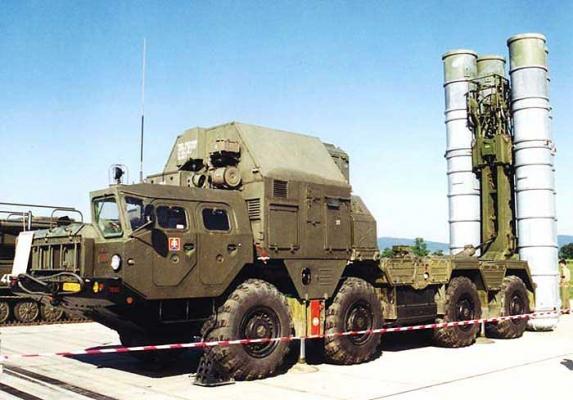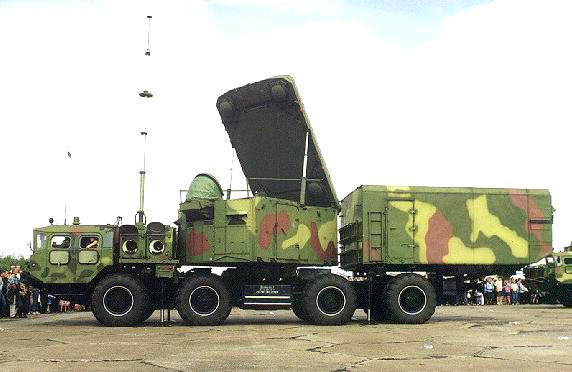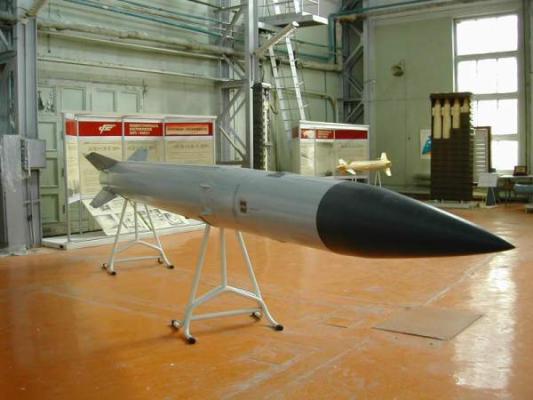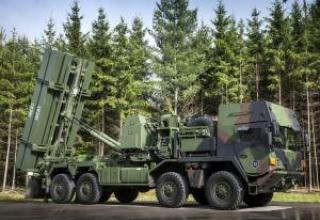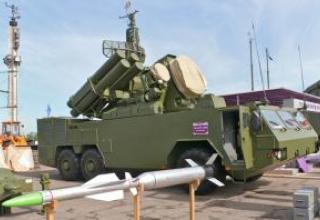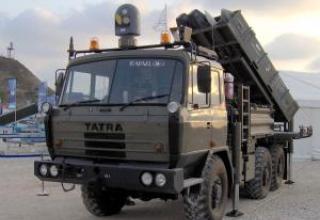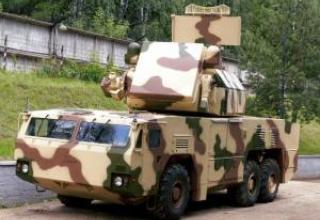The S-300PS antiaircraft missile system is designed to defend critical administrative, industrial and military facilities against all types of air attacks in the full range of their practical application, including permanent combat duty. The SAM system ensures the destruction of modern and advanced aircraft, cruise missiles, ballistic and other targets flying at speeds of up to 1,200 m/s in the area of up to 75 (90) km in range at altitudes from 25 m to the practical ceiling of their combat application, in conditions of massive attack, in a complex tactical and interference environment. The system is all-weather and can be operated in various climatic zones.
S-300PS is a self-propelled version of the anti-aircraft missile system S-300P and was code-named NATO - SA-10B Grumble. The system has been in service since 1982. The main developer is NPO "Almaz", chief designer A. Lemansky. The system consisted of 5B55R (B-500R) missiles created by the Fakel Design Bureau (Moscow) and produced by the North Plant (Leningrad). Self-propelled launchers were developed at the KBSM under the supervision of Chief Designer A.F. Utkin, and since 1979 under the supervision of N.A. Trofimov.
The creation of this complex was conditioned by the analysis of the experience of combat application of SAMs in Vietnam and the Middle East, where the survival of SAMs largely contributed to their mobility, the ability to get out from under attack "in front of the enemy's nose" and quickly prepare for battle at a new position. The new complex had a record short deployment time of 5 minutes, making it difficult to defend against enemy aircraft. The export version of the S-ZEPS system, which features minor changes in its equipment, received the designation S-ZEPMU (code designation NATO - SA-10C Grumble).
Further development of "C-300PS" ("C-300PMU") is the system S-ZOOPMU-1 with enhanced tactical and technical characteristics, adopted for service in 1993.
Composition:
The anti-aircraft missile system C-ZEPS (S-300PMU) is a part of it:
- 5B55P anti-aircraft guided missiles
- anti-aircraft missile system 90G6, which has a composition
- Command post 5H63C with illumination and pointing radar (RPN) 30H6;
- up to four 5P85SD launchers, each of which consists of one 5P85S main launcher and two additional 5P85D boosters,
- autonomous radar detection and target designation means - radar 76N6 and/or radar 36D6 (to be added)
- technical support facilities.
The 90Zh6 SAM can be paired with the 83M6E automated control systems.
Launching complex 5П85СД
The 5P85SD complex includes:
- The main 5P85S PU equipped with a container for preparation and control of F3S missiles launch,
- up to two "additional" PU 5P85D, controlled through an F3C container on PU 5P85C.
The launchers of both types carry four transport and launch containers (TLC) with 5B55R missiles, are equipped with 5C18A autonomous power supply system and are mounted on MAZ-543M chassis of heavy-duty cross-country vehicles. The weight of PU 5P85S is 42150 kg. Dimensions of the launcher: length - 13.11 m, width - 3.15 m, height - 3.8 m.
PU 5P85D in position are installed in pairs relative to PU 5P85C in such a way that the distance between the cabins is 2-3 meters (which is determined by the length of the cable connecting PU 5P85D to the container F3C), and the distance between the bags of TPK - 5-6 meters. All PP 5P85S should be oriented to the cabins on the tap changer 30H6 (exactly angular location of the tap changer is determined by the peppers on the container F2S with the help of artillery panoramas installed on the tap changer 5P85S) and are located at a distance of up to a hundred meters from it. Communication of the 5P85S launchers with the PBU to control the operation of the F3S container and ensure missile preparation is carried out via a radio line through an antenna located behind the cabin of the PU driver on the F3S container. Late PU series uses disc-shaped antenna of communication system.
Machines of launch complexes are mounted on hydraulic supports when deployed in combat position. Horizontal errors are almost completely compensated by a special PU unit.
Command post 5H63C:
5H63C command post is mounted on F20 chassis on the basis of MAZ-543M vehicle and has in its composition:
- On-load tap-changer 30H6 - F1C container - receiving and transmitting cabin with requester
- Combat control cabin (CBU) - hardware container F2K.
The F20 chassis includes: a 5C18A power supply system with two gas turbine power units (GAP) and a power take-off generator (from the MAZ vehicle engine) and a telescopic antenna-mast device (AMU) for communication with the higher command post and automatic control system.
Highly automated multifunction radar for illumination of targets and guidance of missiles (RPN) 30H6, carries out reception and development of target designation from control means 83M6E and attached autonomous sources of information, detection (including in autonomous mode), selection of targets for priority firing, capture and auto tracking of targets, identification of their nationality, capture, tracking and guidance of missiles, illumination of targets to ensure the operation of semi-active heads of guided missiles. Automatic viewing of the ground edge, where low-altitude targets may appear, is performed. The complex assesses the interference situation and suppresses the interference of both passive and active. The 30H6 on-load tap-changer provides simultaneous targeting of up to 12 missiles at six targets of different types.
The design of the F20 chassis allows for combat operations directly "from the wheels" after the machine is mounted on hydraulic supports (horizontal errors are handled by a special computing unit located in the F1C container). Cable connection to other elements of the complex and power supply sources is made if necessary and if time is available.
When the division location is more than 20 km away from the system command post, AMU FL-95 (FL-95M, FL-95MA) - telescopic farm mast up to 25 meters high on the chassis of ZIL-131N (AMU "Sosna") - is introduced into the division for a sustainable exchange of information on the air installation and combat operations.
In order to expand the capabilities for detecting and tracking low-altitude targets in the deployment of anti-aircraft divisions and radio-technical troops (RTV) in wooded or rugged terrain in the country's air defense forces, stationary towers have been used since the 1960s to lift the CNR antenna posts, reconnaissance radars and target designation. As applied to C300P complexes of various modifications for placing the RNP antenna post there was developed a 40B6M universal mobile tower with the height of about 25 meters towed in transport position by MAZ-537 tractor. The tower was adopted for service in the late 70s - early 80s. A little later the 40B6MD tower with a height of about 39 meters was developed and adopted for service. It differs from the 40B6M by an additional 13-meter extension. For transportation of additional section of the 40V6MD tower a road train based on MAZ-938 semitrailer is used. Installation of tower 40V6M and lifting of on-load tap-changer is carried out in 1 hour by the tower's regular means, for tower 40V6MD - in 2 hours with the use of regular means and additional crane type KT-80 "Janvarets" or similar to it in terms of lifting capacity and height of the lifting cargo.
The crane KT-80 (KS-7571) with the lifting capacity of up to 80 tons was created by SGCTB using the chassis of mobile launchers of the Pioneer strategic missile system - a six-axle MAZ-547A off-road vehicle. Production of cranes was carried out by PO "Zavod im. January Uprising" (Odessa).
The time of the complex deployment and transfer from the camping position to the combat position is determined by the time of automatic control of the complex systems functioning and the transmitters output to the high voltage mode. All operations are performed by combat calculations from the cabins of the launch complexes and the CBU.
In the course of combat operations, the interaction of all participating equipment is carried out via telemetry communication channels (radio line). Cable connection is provided between launchers 5П85Д and 5П85С (to container F3С) of complexes 5В85СД and between launchers 5В85С and containers F2К. If time is available, external power supply systems (SVEP) are connected to corresponding consumers.
The firing rate is 3.5 seconds and up to 6 targets can be simultaneously fired by 12 missiles with up to two missiles pointed at each target. The mode of firing at ground targets is provided.
Anti-aircraft guided missile 5B55R
The 5B55R is designed to engage modern and advanced air targets, including strategic and tactical aircraft, cruise missiles, as well as ballistic and tactical missiles of various bases and other air targets. The missile is a single-stage and is designed according to the normal aerodynamic scheme. Equipped with a highly effective solid propellant engine, consists of a number of compartments which are located in the direction finder, equipment compartment (airborne equipment is made in the form of a monoblock), shrapnel and carbon monoblock combat unit, solid propellant rocket engine, control units for rocket rudder (see photo 1, photo 2). The missile's launch is vertical, using the catapult installed in the TIC without first turning the launcher towards the target. After the exit of the rocket from the TPK air rudder-elerons under the action of torsions opened in the working position, the engine starts. After the engine is started, the rocket tilts in the required direction depending on the target position.
To ensure the inclination, the rocket is equipped with gas-aeron rudders, which bring it to the required trajectory angle in the first seconds after launch, when the rocket's speed is still low and the air-aeron rudders are not effective. Later on, the gas-fired aileron rudders are detached from the aileron rudder control mechanism by means of pyropropatrons, and air-fired aileron rudders are used to provide controlled flight.
The missile's high maneuverability and high power shrapnel and fragmentation warheads ensure that targets are effectively hit.
The missile does not require inspection and adjustment during its lifetime - 10 years.
Low-altitude detector 5H66M
For more successful detection of low-altitude targets, the division is assigned a 5H66M low-altitude detector (IEE) mounted on a universal mobile tower, developed in NPO Utes (Moscow) under the leadership of L. Shulman and adopted in the late 70's by the country's Air Defense Forces.
The 5H66M IEE (see photo) is supplied to the troops:
- antenna post F52M,
- universal tower 40В6М (40В6МД),
- autonomous power supply system (SAES) - diesel power plant 5I57 (5I57A)
- peripherals in an F2 container
- switchgear 5I58 (or 63T6A).
The IEE, which determines the azimuth, range and speed of the target, is controlled from the F52M container or remotely from the F2K container. The accuracy of coordinate determination: range - 250 m, azimuth - 20 angular minutes, speed - 2.4 m/s. Input power - 55 kW. IEE in transport condition is transported by two 5T58 road trains (truck tractor KrAZ-250 and trailer produced by ChMZAP).
Technical means assigned to the C300PS division
When conducting autonomous combat operations in isolation from the system's command post, the division is assigned the 36D6 (or 19Zh6) all-altitude three-axis radar. The antenna post with a turning device, the radar cabin is mounted on a single semi-trailer. The station is equipped with a diesel-electric station 5I57. At the combat position the radar operates directly from the semitrailer or its antenna and turning device can be installed on the 40V6M (40V6MD) tower.
Two semitrailers OdAZ-828M with ZIP-1B (P3 and P4) and ED cab ("Operating Documentation" - semitrailer OdAZ-828M or truck KrAZ-225/KrAZ-260 with KUNG) towed by ZIL-131 truck tractors are placed at some distance from the centre of the position (tap changer location).
When conducting combat operations as part of the S-300PS regiment, to determine the precise coordinates of the firing division relative to the system command post (KPS), when changing its position, the division is assigned a 1T12-2M top gun mount on the basis of GAZ-66 or UAZ-3151 vehicle, which, when deployed at a new position, is usually installed in the course of the line movement with the on-load tap-changer at some distance.
A division commander's vehicle and a command and staff vehicle (UAZ-3151 or GAZ-66) equipped with the R-123M combined radio station (R-125P2 as part of the R-134, R-173 and R853B1 radios) are designed to control the division on the march when changing positions. To provide the machines with power supply, power unit AB-1-P285-VVI is supplied to the position.
To provide cover from the attacking enemy helicopters and to fight effectively against the ground enemy (landing party), the division is given an anti-aircraft machine gun "Utyos" - a large-caliber machine gun NSV (12.7-mm) on a 6U6 machine gun.
When placed on the prepared position, the division is provided with external power supply systems (SVEP), power supply units (modules): 94E6, 98E6 and 99E6 as part of DES 5I57A and 63T6A switchgear (two switchgear cabins for 99E6) - for power supply of launch complexes, IHE, on-load tap-changers and F2K container, respectively. All DES and DCP of S-300P system are mounted in bodies-vans of KT10 type on the basis of MAZ-5224V trailer chassis. The weight of diesel-electric station is 13600 kg, distribution and converter unit 63T6A is 11930 kg.
Carried transformer substations (TPS) 82X6, 83X6 are used when placing the division of positions with the possibility of connection to the industrial power grid.
To increase the division's autonomy, the ATS-5.5 tank truck can be assigned to transport diesel fuel on the basis of the KAMAZ-4310 or a fuel tanker on the basis of the Ural-375, ZIL-131 vehicles, a maintenance vehicle - the MTO-4S, a water truck, usually on the basis of the ZIL-130, ZIL-131 or GAZ-66 vehicles.
When changing the combat position, vehicles for towing trailers, transporting personnel and property come from the regiment car service.
In some cases, a combat duty support module (MOBD) can be a part of the means attached to divisions. It consists of four self-propelled chassis type MAZ-543 with blocks: dining room, dormitory, guard room (all on MAZ-543M chassis), power unit (on MAZ-543A chassis). In addition, a trailer mounted diesel power plant is introduced.
All MAZ-543M vehicles of the S-300PS division are equipped with night vision devices and radio stations for communication on the march.
For carrying out driving training during recharging of self-propelled PU, they are equipped with dimensional and mass layouts of TPK (it is possible to install a variant of TPK for non-applicable in the complex missile modification). For temporary storage of TPK in divisions and for storage of the stock of missiles in TPK in the armament warehouses are used packages 5P32, which allow their multi-level installation in racks. The transportation of missiles in the industrial and technological complex, placed in 5P32 packages, is carried out by 5T58-2 road trains or in ordinary gondola cars.
For recharging of 5P85 launchers of all modifications 5T99 on the chassis of KrAZ-255 or 5T99M on the chassis of KrAZ-260 is used; it is also possible to install rockets on PU using KS-4561AM truck crane. The KS-4561A crane of 16 tons lifting capacity is mounted on the KrAZ-257K1 truck chassis. The crane based on the KrAZ-250 truck chassis has the KS-4561A-1 index. At present, truck cranes of KS-4561 type designed and manufactured by Kamyshinsky Crane Plant are out of production. PU recharge facilities are not included in the firing divisions. At present the Air Defense Forces are supplied with new charging machines with a modified manipulator design.
Characteristics:
| Defeat zone boundaries, km | |
| - long-range (aerodynamic target) | 75 |
| - long-distance (BMD) | 25 |
| - near | 5 |
| Target kill altitude, km | |
| - minimum (aerodynamics) | 0,025 |
| - maximum (aerodynamics) | 27 |
| Maximum RMS speed, m/s | up to 2000 |
| Maximum target speed, m/sec. | 1200 |
| KPU Review Branch (Azimuth), hail | 90 |
| Number of accompanied targets | up to 12 |
| Number of targets fired | up to 6 |
| Number of simultaneously guided missiles | up to 12 |
| Rate of fire, sec | 3-5 |
| Deployment/cooling time, mines | 5/5 |
| Number of missiles in the complex | up to 48 |
Testing:
The first combat use of the S-200 SAM system took place in 1982 in Syria, where at a distance of 190 km the E-2C "Hawkeye" DRLO was shot down, after which the American aircraft carrier fleet withdrew from the Lebanese coast. The Libyan S-200 complexes took part in repulsing an attack by American FB-111 bombers and possibly shot down one bomber.
On the basis of the 5B28 anti-aircraft missile of the S-200B complex a hypersonic flying laboratory "Cold" has been created to test hypersonic direct-flow air jet engines. The choice of this missile was based on the fact that the parameters of its flight path were close to those required for flight tests of the Hyper-Sonic Propulsion System. It was also considered important that the missile had been decommissioned and its cost was low. The missile's combat unit was replaced by the head compartments of the GLL "Kholod", which housed the flight control system, a liquid hydrogen tank with displacement system, a hydrogen flow control system with measuring devices and, finally, the experimental HPVRD E-57 of axially symmetric configuration.
Sources:
- "Зенитная ракетная система С-300". Приложение к сборнику "Невский Бастион", выпуск 3, статья "Зенитный ракетный комплекс С-300ПС (С-300ПМУ)", С-Пб, 1997.
- "Авиация и космонавтика", журнал, №8, 1999
- "Независимое военное обозрение", №6, 1999
- "Тайфун" альманах, "Атомные ракетные крейсеры проекта 1144"
- Василин Н.Я., Гуринович А.Л. "Зенитные ракетные комплексы" .-Мн.: ООО "Попурри", 2002- 464с.
- AIR SHOW, Augist, 12, 2000 / © Sergei Frolov
- Самоходная пусковая установка 5П85С / © Иван Мотлик
- С-300П "Зенитно-ракетная система" /"Русская сила"

